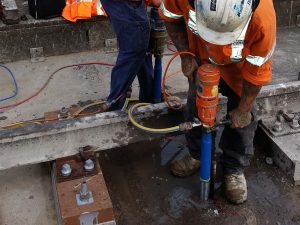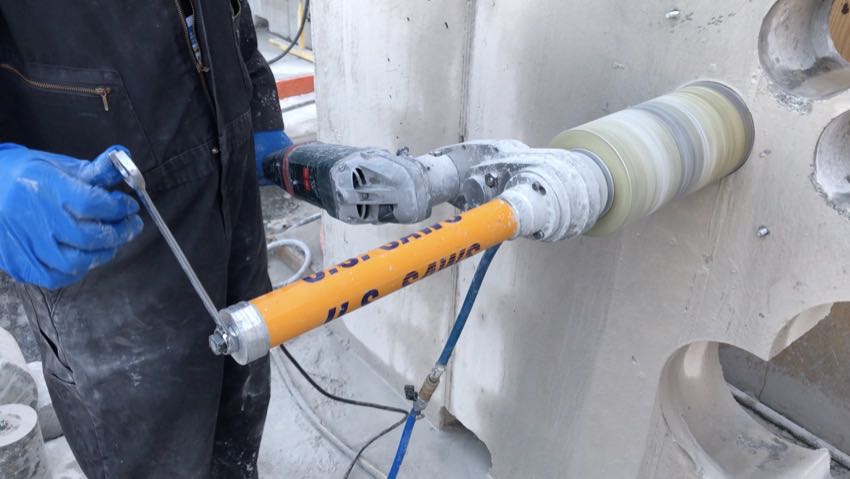How Deep Can You Core Drill Concrete?
Concrete core drilling is a vital process in construction, allowing for the creation of precise holes for various purposes, such as installing utilities, anchoring structures, or conducting material testing. If you’re involved in construction or planning a project that requires core drilling, it’s essential to understand how deep you can core drill into concrete. In this comprehensive guide, we’ll explore the factors that influence core drilling depth and provide you with valuable insights into maximizing the efficiency and safety of your core drilling operations.
Factors Affecting Core Drilling Depth
Before delving into the depths you can achieve with concrete core drilling, it’s crucial to grasp the key factors that influence the process:

1. Concrete Composition
The composition of the concrete greatly affects core drilling depth. Standard concrete mixes consist of cement, water, and aggregates. However, variations in aggregate size, type, and overall composition can impact drilling capabilities. Harder concrete with denser aggregates will generally be more challenging to drill to significant depths.
2. Diamond Core Bit Quality
The quality of the diamond core bit is paramount to the success of your core drilling project. Diamond bits are known for their durability and ability to cut through tough materials like concrete. High-quality bits can penetrate deeper, making investing in a top-notch core bit a wise choice for achieving greater depths.
3. Drilling Machine Power
The power and performance of the drilling machine play a significant role in determining drilling depth. More powerful machines can exert greater force and torque, enabling them to cut through concrete with less effort. When attempting to drill to considerable depths, a robust drilling machine is essential.
4. Bit Diameter
The diameter of the core bit you use also affects drilling depth. Smaller diameter bits are more manageable but may not reach the same depths as larger ones. Selecting the appropriate bit diameter for your specific project is essential for achieving the desired depth. Learn about drill it group here.
5. Operator Skill and Experience
The skill and experience of the operator are often underestimated factors in core drilling. Experienced operators can control the machine more effectively, optimizing the drilling process for greater depths while ensuring safety.
Typical Core Drilling Depths
Concrete core drilling is a versatile process capable of reaching various depths depending on the factors mentioned above. Here’s a general guideline for the typical depths you can achieve:
1. Standard Depths
For most construction projects, core drilling depths range from 2 inches to 12 inches (5 cm to 30 cm). This range accommodates the installation of utilities, creating openings for HVAC systems, or conducting material sampling for analysis.
2. Greater Depths
In specialized applications or with the right equipment and expertise, core drilling can reach much greater depths, exceeding 24 inches (60 cm). Such projects may involve creating holes for large-diameter pipes, deep foundation installations, or geological research.
Tips for Achieving Greater Core Drilling Depths
If you need to core drill to substantial depths, here are some tips to help you achieve your goals:
1. Select the Right Equipment
Invest in high-quality diamond core bits and a powerful drilling machine to ensure efficiency and safety during deep drilling projects.
2. Use Water Cooling
Water cooling is essential when drilling deep into concrete. It helps keep the bit cool and lubricated, reducing friction and preventing overheating.
3. Regular Maintenance
Keep your equipment in top condition with regular maintenance. Dull or damaged core bits will hinder your drilling depth capabilities.
4. Proper Technique
Train your operators in proper core drilling techniques. Knowledgeable and skilled operators can maximize drilling efficiency and safety.
5. Safety Measures
Always prioritize safety when drilling deep into concrete. Use appropriate safety gear, follow industry standards, and conduct a thorough risk assessment before beginning any drilling project.
Conclusion
Concrete core drilling is a valuable technique in the construction industry, offering the flexibility to create precise holes at various depths. While standard depths typically range from 2 to 12 inches, with the right equipment, expertise, and safety measures, it’s possible to achieve much greater depths. Understanding the factors that influence core drilling depth and implementing best practices can help you successfully complete your drilling projects while ensuring efficiency and safety. Whether you’re working on a small residential project or a large-scale commercial development, core drilling is a versatile method that can meet your specific needs, making it an essential skill for any construction professional.

